使用 GPU 云服务器训练 ViT 模型
最后更新时间:2024-01-11 17:11:13
说明:
本文来自GPU 云服务器用户实践征文,仅供学习和参考。
操作场景
本文介绍如何使用 GPU 云服务器进行 ViT 模型离线训练,完成简单的图像分类任务。
ViT 模型简介
ViT 全称 Vision Transformer,该模型由 Alexey Dosovitskiy 等人提出,在多个任务上取得 SoTA 结果。示意图如下:
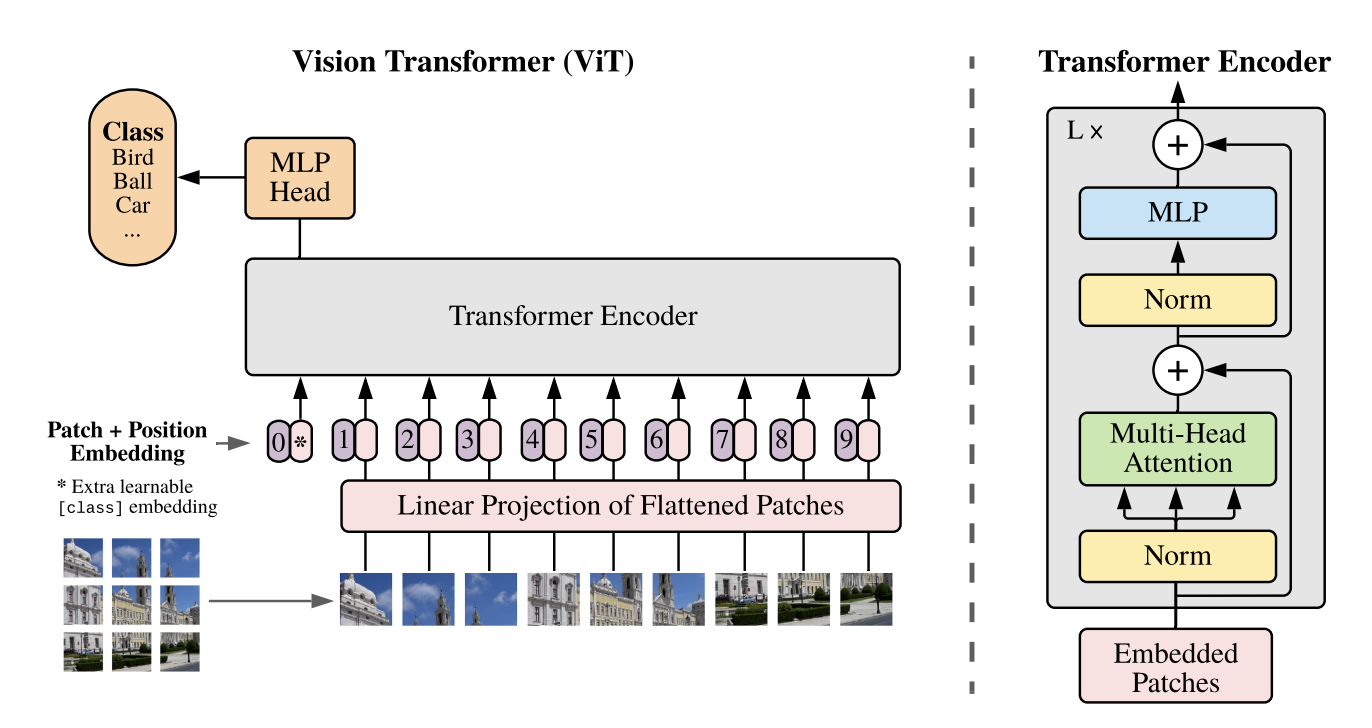

对于一幅输入的图像,ViT 将其划分为多个子图像 patch,每个 patch 拼接 position embedding 后,和类别标签一起作为 Transfomer Encoder 的一组输入。而类别标签位置对应的输出层结果通过一个网络后,即得到 ViT 的输出。在预训练状态下,该结果对应的 ground truth 可以使用掩码的某个 patch 作为替代。
示例环境
实例类型:本文可选实例为 GN7 与 GN8,结合 Technical 提供的 GPU 对比,Turing 架构的 T4 性能优于 Pascal 架构的 P40。本文最终选用 GN7.5XLARGE80。
所在地域:由于可能需上传一些尺寸较大的数据集,需优先选择延迟最低的地域。本文使用 在线 Ping 工具测试,所在位置到提供 GN7 的重庆区域延迟最小,因此选择重庆区域。
系统盘:100GB 高性能云硬盘。
操作系统:Ubuntu 18.04
带宽:5M
本地操作系统:MacOS
操作步骤
设置实例免密登录(可选)
1. (可选)您可在本机
~/.ssh/config 中,配置服务器的别名。本文创建别名为 tcg。2. 通过
ssh-copy-id 命令,将本机 SSH 公钥复制至 GPU 云服务器。3. 在 GPU 云服务器中执行以下命令,关闭密码登录以增强安全性。
echo 'PasswordAuthentication no' | sudo tee -a /etc/ssh/ssh\\_config
4. 执行以下命令,重启 SSH 服务。
sudo systemctl restart sshd
PyTorch-GPU 开发环境配置
若使用 GPU 版本的 PyTorch 进行开发,则需要进行一些环境配置。步骤如下:
1. 安装 Nvidia 显卡驱动。
执行以下命令,安装 Nvidia 显卡驱动。
sudo apt install nvidia-driver-418
安装完成后执行如下命令,查看是否安装成功。
nvidia-smi
返回结果如下图所示,表示已安装成功。
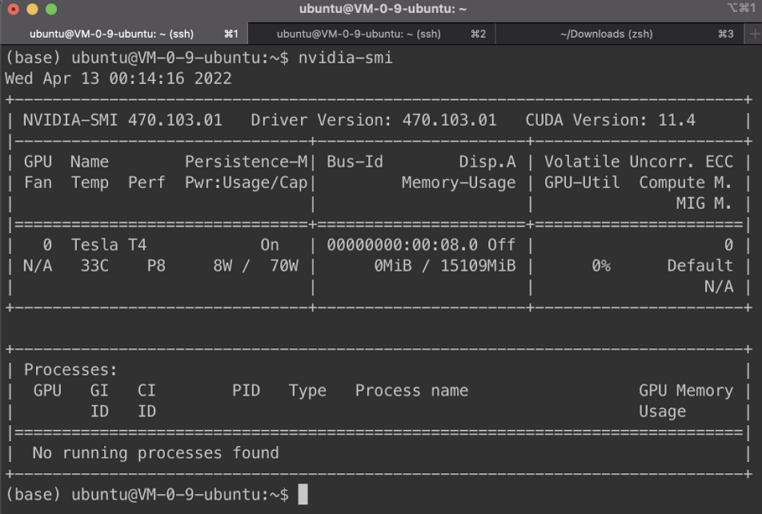

2. 配置 conda 环境。
依次执行以下命令,配置 conda 环境。
wget https://repo.anaconda.com/miniconda/Miniconda3-py39\\_4.11.0-Linux-x86\\_64.sh
chmod +x Miniconda3-py39\\_4.11.0-Linux-x86\\_64.sh
./Miniconda3-py39\\_4.11.0-Linux-x86\\_64.sh
rm Miniconda3-py39\\_4.11.0-Linux-x86\\_64.sh
3. 编辑
~/.condarc 文件,加入以下软件源信息,将 conda 的软件源替换为清华源。channels:- defaultsshow\\_channel\\_urls: truedefault\\_channels:- https://mirrors.tuna.tsinghua.edu.cn/anaconda/pkgs/main- https://mirrors.tuna.tsinghua.edu.cn/anaconda/pkgs/r- https://mirrors.tuna.tsinghua.edu.cn/anaconda/pkgs/msys2custom\\_channels:conda-forge: https://mirrors.tuna.tsinghua.edu.cn/anaconda/cloudmsys2: https://mirrors.tuna.tsinghua.edu.cn/anaconda/cloudbioconda: https://mirrors.tuna.tsinghua.edu.cn/anaconda/cloudmenpo: https://mirrors.tuna.tsinghua.edu.cn/anaconda/cloudpytorch: https://mirrors.tuna.tsinghua.edu.cn/anaconda/cloudpytorch-lts: https://mirrors.tuna.tsinghua.edu.cn/anaconda/cloudsimpleitk: https://mirrors.tuna.tsinghua.edu.cn/anaconda/cloud
4. 执行以下命令,设置 pip 源为腾讯云镜像源。
pip config set global.index-url https://mirrors.cloud.tencent.com/pypi/simple
5. 安装 PyTorch。
执行以下命令,安装 PyTorch。
conda install pytorch torchvision cudatoolkit=11.4 -c pytorch --yes
依次执行以下命令,查看 PyTorch 是否安装成功。
python
import torch
print(torch.cuda.is_avaliable())
返回结果如下图所示,表示 PyTorch 已安装成功。


准备实验数据
本次训练的测试任务是图像分类任务,使用了腾讯云在线文档中用到的花朵图像分类数据集。该数据集包含5类花朵,数据大小为218M。数据集抽样展示如下:(各类别下花朵照片示例)
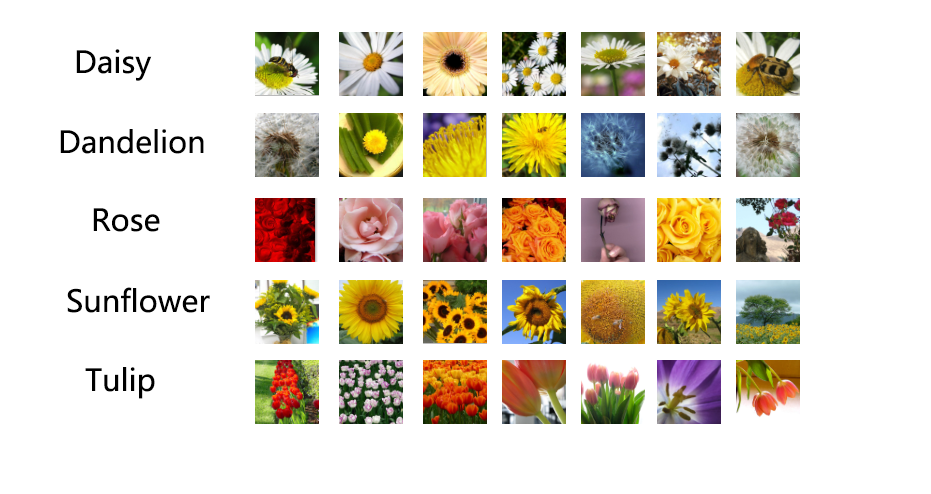

原始数据集中的各个分类数据分别存放在类名对应的文件夹下。首先需将其转化为 imagenet 对应的标准格式。按4:1划分训练和验证集,使用以下代码进行格式转换:
# split data into train set and validation set, train:val=scaleimport shutilimport osimport mathscale = 4data\\_path = '../raw'data\\_dst = '../train\\_val'#create imagenet directory structureos.mkdir(data\\_dst)os.mkdir(os.path.join(data\\_dst, 'train'))os.mkdir(os.path.join(data\\_dst, 'validation'))for item in os.listdir(data\\_path):item\\_path = os.path.join(data\\_path, item)if os.path.isdir(item\\_path):train\\_dst = os.path.join(data\\_dst, 'train', item)val\\_dst = os.path.join(data\\_dst, 'validation', item)os.mkdir(train\\_dst)os.mkdir(val\\_dst)files = os.listdir(item\\_path)print(f'Class {item}:\\n\\t Total sample count is {len(files)}')split\\_idx = math.floor(len(files) \\* scale / ( 1 + scale ))print(f'\\t Train sample count is {split\\_idx}')print(f'\\t Val sample count is {len(files) - split\\_idx}\\n')for idx, file in enumerate(files):file\\_path = os.path.join(item\\_path, file)if idx <= split\\_idx:shutil.copy(file\\_path, train\\_dst)else:shutil.copy(file\\_path, val\\_dst)print(f'Split Complete. File path: {data\\_dst}')
数据集概览如下:
Class roses:Total sample count is 641Train sample count is 512Validation sample count is 129Class sunflowers:Total sample count is 699Train sample count is 559Validation sample count is 140Class tulips:Total sample count is 799Train sample count is 639Validation sample count is 160Class daisy:Total sample count is 633Train sample count is 506Validation sample count is 127Class dandelion:Total sample count is 898Train sample count is 718Validation sample count is 180
为了加速训练过程,我们进一步将数据集转换为 Nvidia-DALI 这种 GPU 友好的格式。DALI 全称 Data Loading Library,该库可以通过使用 GPU 替代 CPU 来加速数据预处理过程。在已有 imagenet 格式数据的前提下,使用 DALI 只需运行以下命令即可:
git clone https://github.com/ver217/imagenet-tools.gitcd imagenet-tools && python3 make\\_tfrecords.py \\--raw\\_data\\_dir="../train\\_val" \\--local\\_scratch\\_dir="../train\\_val\\_tfrecord" && \\python3 make\\_idx.py --tfrecord\\_root="../train\\_val\\_tfrecord"
模型训练结果
为了便于后续训练分布式大规模模型,本文在分布式训练框架 Colossal-AI 的基础上进行模型训练和开发。Colossal-AI 提供了一组便捷的接口,通过这组接口能方便地实现数据并行、模型并行、流水线并行或者混合并行。
参考 Colossal-AI 提供的 demo,本文使用 pytorch-image-models 库所集成的 ViT 实现,选择最小的
vit\\_tiny\\_patch16\\_224 模型,该模型的分辨率为224*224, 每个样本被划分为16个 patch。1. 根据版本选择页面通过以下命令,安装 Colossal-AI 和 pytorch-image-models:
pip install colossalai==0.1.5+torch1.11cu11.3 -f https://release.colossalai.org
pip install timm
2. 参考 Colossal-AI 提供的 demo,编写模型训练代码如下:
from pathlib import Pathfrom colossalai.logging import get\\_dist\\_loggerimport colossalaiimport torchimport osfrom colossalai.core import global\\_context as gpcfrom colossalai.utils import get\\_dataloader, MultiTimerfrom colossalai.trainer import Trainer, hooksfrom colossalai.nn.metric import Accuracyfrom torchvision import transformsfrom colossalai.nn.lr\\_scheduler import CosineAnnealingLRfrom tqdm import tqdmfrom titans.utils import barrier\\_contextfrom colossalai.nn.lr\\_scheduler import LinearWarmupLRfrom timm.models import vit\\_tiny\\_patch16\\_224from titans.dataloader.imagenet import build\\_dali\\_imagenetfrom mixup import MixupAccuracy, MixupLossdef main():parser = colossalai.get\\_default\\_parser()args = parser.parse\\_args()colossalai.launch\\_from\\_torch(config='./config.py')logger = get\\_dist\\_logger()# build modelmodel = vit\\_tiny\\_patch16\\_224(num\\_classes=5, drop\\_rate=0.1)# build dataloaderroot = os.environ.get('DATA', '../train\\_val\\_tfrecord')train\\_dataloader, test\\_dataloader = build\\_dali\\_imagenet(root, rand\\_augment=True)# build criterioncriterion = MixupLoss(loss\\_fn\\_cls=torch.nn.CrossEntropyLoss)# optimizeroptimizer = torch.optim.SGD(model.parameters(), lr=0.1, momentum=0.9, weight\\_decay=5e-4)# lr\\_schedulerlr\\_scheduler = CosineAnnealingLR(optimizer, total\\_steps=gpc.config.NUM\\_EPOCHS)engine, train\\_dataloader, test\\_dataloader, \\_ = colossalai.initialize(model,optimizer,criterion,train\\_dataloader,test\\_dataloader,)# build a timer to measure timetimer = MultiTimer()# create a trainer objecttrainer = Trainer(engine=engine, timer=timer, logger=logger)# define the hooks to attach to the trainerhook\\_list = [hooks.LossHook(),hooks.LRSchedulerHook(lr\\_scheduler=lr\\_scheduler, by\\_epoch=True),hooks.AccuracyHook(accuracy\\_func=MixupAccuracy()),hooks.LogMetricByEpochHook(logger),hooks.LogMemoryByEpochHook(logger),hooks.LogTimingByEpochHook(timer, logger),hooks.TensorboardHook(log\\_dir='./tb\\_logs', ranks=[0]),hooks.SaveCheckpointHook(checkpoint\\_dir='./ckpt')]# start trainingtrainer.fit(train\\_dataloader=train\\_dataloader,epochs=gpc.config.NUM\\_EPOCHS,test\\_dataloader=test\\_dataloader,test\\_interval=1,hooks=hook\\_list,display\\_progress=True)if \\_\\_name\\_\\_ == '\\_\\_main\\_\\_':main()
模型的具体配置如下所示:
from colossalai.amp import AMP\\_TYPEBATCH\\_SIZE = 128DROP\\_RATE = 0.1NUM\\_EPOCHS = 200CONFIG = dict(fp16=dict(mode=AMP\\_TYPE.TORCH))gradient\\_accumulation = 16clip\\_grad\\_norm = 1.0dali = dict(gpu\\_aug=True,mixup\\_alpha=0.2)
模型运行过程如下图所示, 单个 epoch 的时间在20s以内:
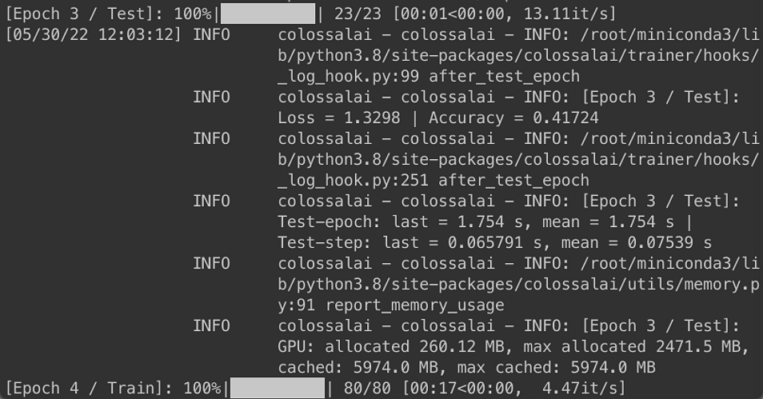

结果显示模型在验证集上达到的最佳准确率为66.62%。我们也可以通过增加模型的参数量,例如修改模型为 v。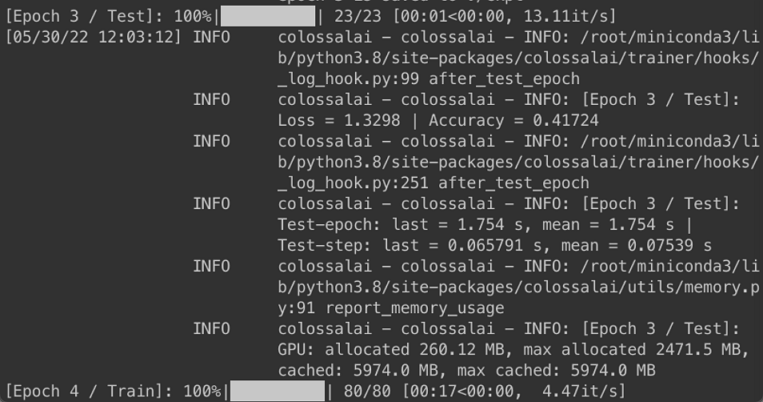

总结
本次使用过程中遇到的最大的问题是从 GitHub 克隆非常缓慢,为了解决该问题,尝试使用了 tunnel 和 proxychains 工具进行提速。但该行为违反了云服务器使用规则,导致了一段时间的云服务器不可用,最终通过删除代理并提交工单的方式才得以解决。
借此也提醒其他用户,进行外网代理不符合云服务器使用规范,为了保证您服务的稳定运行,切勿违反规定。
参考
[1] Dosovitskiy, Alexey, et al. "An image is worth 16x16 words: Transformers for image recognition at scale." arXiv preprint arXiv:2010.11929 (2020).
[2] NVIDIA/DALI
[3] Bian, Zhengda, et al. "Colossal-AI: A Unified Deep Learning System For Large-Scale Parallel Training." arXiv preprint arXiv:2110.14883 (2021).
文档反馈

